For many decades, archaeologists, anthropologists, and ethnographers working in Puget Sound, the Salish Sea, and the Northwest Coast would have said that salmon were by far the most crucial food resource for those who lived in this region. So ingrained was this idea that Canadian archaeologist Gregory Monks coined the term “salmonopia” to describe the narrow focus on salmon and how it had long biased researchers away from herring and other foods. Recently, though, a shift has started to occur as researchers have begun to expand their vision beyond the Northwest’s most famous food.
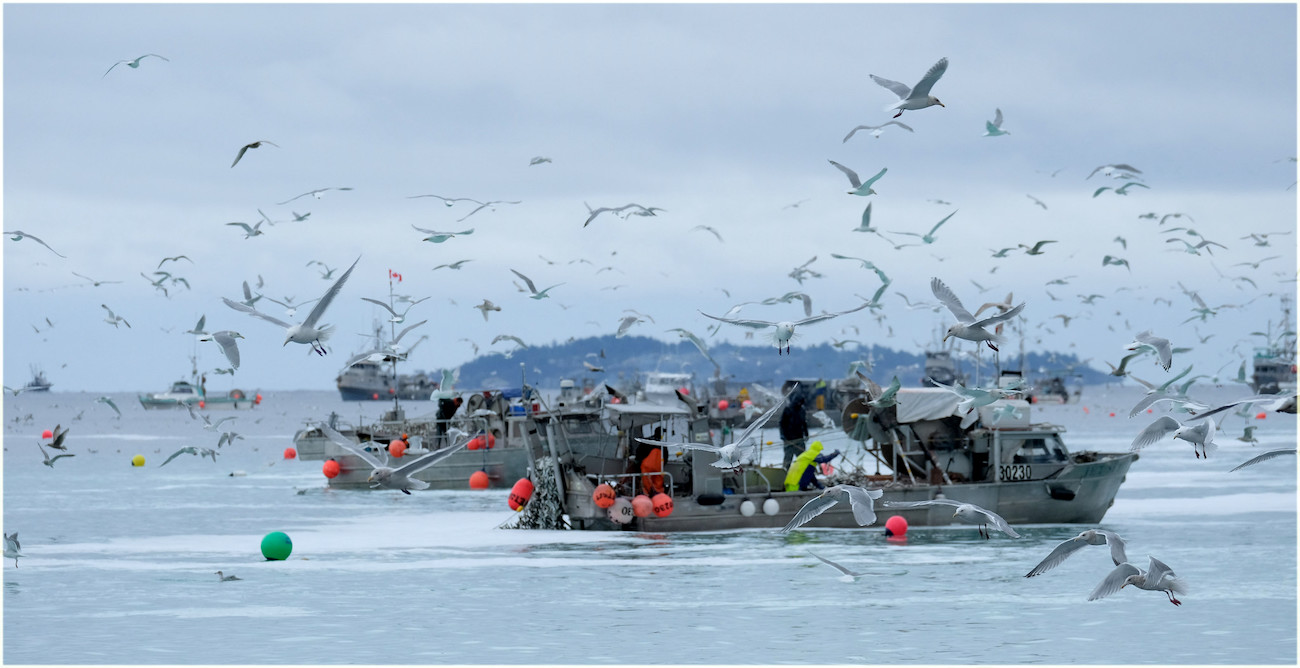
Scientists believe that herring have been a staple of Salish Sea food and culture since humans first arrived here at least 12,500 years ago. That importance has continued into modern times, even as herring numbers have declined in parts of the region.

In 2014, an international team released a study that examined 171 archaeological sites spanning the past 10,700 years of human history. Herring were the most numerous fish specimen in 55 percent of the sites and the most commonly found fish, occurring in all but two of the sites, which ranged from Puget Sound to southeast Alaska. The researchers concluded that herring were “both widespread across the coast and a mainstay of ecological and socio-ecological systems over the Holocene.”
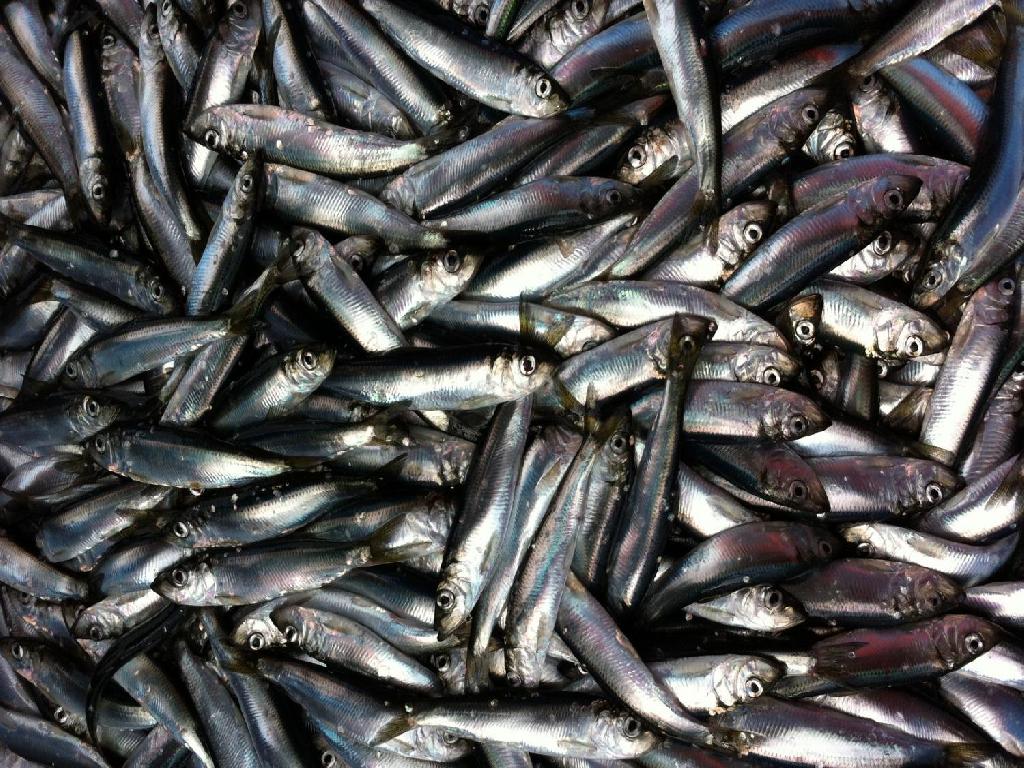
Young adult herring from Puget Sound. Margaret Siple/UW
Although the data in Puget Sound was relatively sparse, two archaeological sites revealed that Native people in the waterway have been eating herring for at least 1,000 years. At Burton Acres on Vashon Island, archaeologist Robert Kopperl found that of 5,731 fish bones he could identify, 4,281 were herring and just 570 were salmon. Further north, at a site in Agate Passage researchers unearthed a curious specimen: Herring nested in littleneck clam nested in a butter clam, a sort of early day canape. Based on his work and the 2014 paper, Kopperl believes that herring have probably been an important food source since people first arrived in Puget Sound, at least 12,500 years ago.
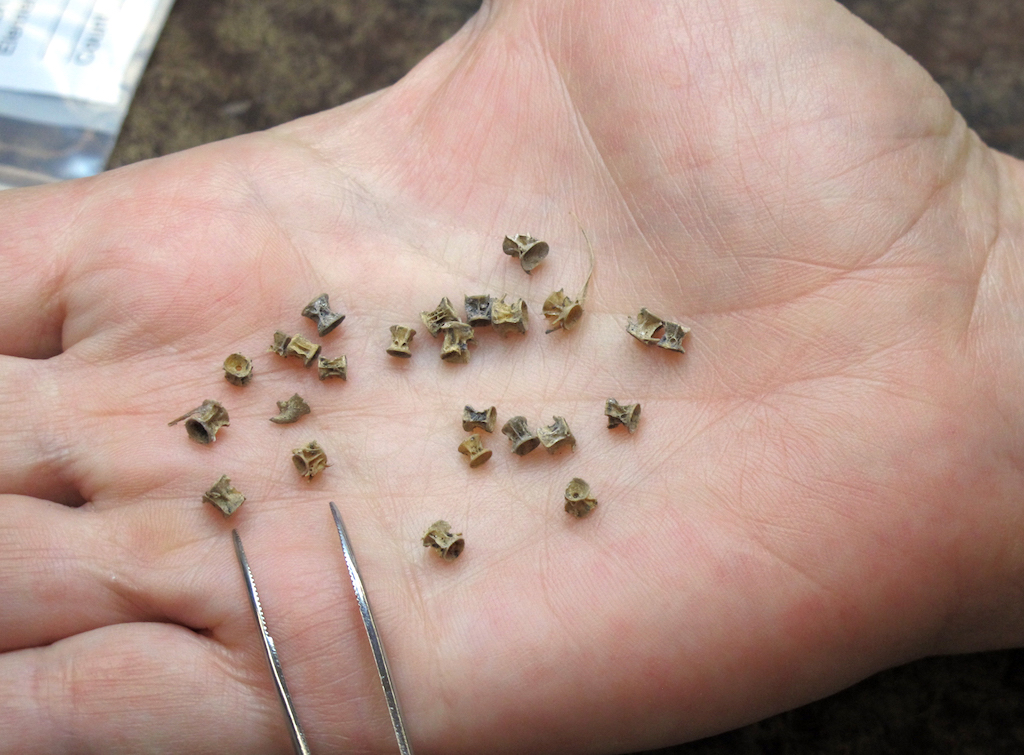
Vertebrae from herring collected at an archaeological site. Jim Barlow/University of Oregon
Within the Sound, some of the earliest observations of herring consumption come from John Keast Lord, a naturalist who served on the British North American Boundary Commission from 1858 to 1862. “Toward the middle of April herring legions commence arriving from seaward in real earnest,” he wrote. One of the primary fishing methods that Lord observed was a herring rake, an 8- to 12-foot-long, wood pole, flattened for about half its length on one side. Jutting out from the flattened part were one-inch long teeth, made of hemlock or fir or bone, set about one inch apart from each other. Riding in a canoe, the herring hunter would sweep the rake through schools of fish, impaling them and afterwards dumping the herring in the canoe.
For larger-scale capture, Lord wrote that people in Puget Sound erected “long dams of latticework, having here and there openings like our salmon-traps” on the waterway’s many acres of mud-flats. Shoal after shoal of herring would pass through the openings “but are destined never to get back to their briny homes.” Employing this method fishers could harvest two to three tons of fish at a single tide. Later ethnologists added that the brush weirs, as the traps were called, also trapped seals that had pursued the herring into the openings.
Spawning grounds
The tide flats provided an additional method of acquiring herring, specifically the eggs, wrote Lord. “The Indians bring down immense quantities of fir-branches, and…distribute them over the flats.” They would also lay out the branches along the shore. During the spring spawn, herring eggs would get entangled in the branches and accumulate in great quantities. After the eggs were dried in the sun, they would be eaten with fish oil. “This spawn is to Indians what caviare is to Russians,” wrote Lord. Further north, anthropologist Franz Boaz wrote that the Kwakiutl used herring roe to bait duck traps, which are set under water.
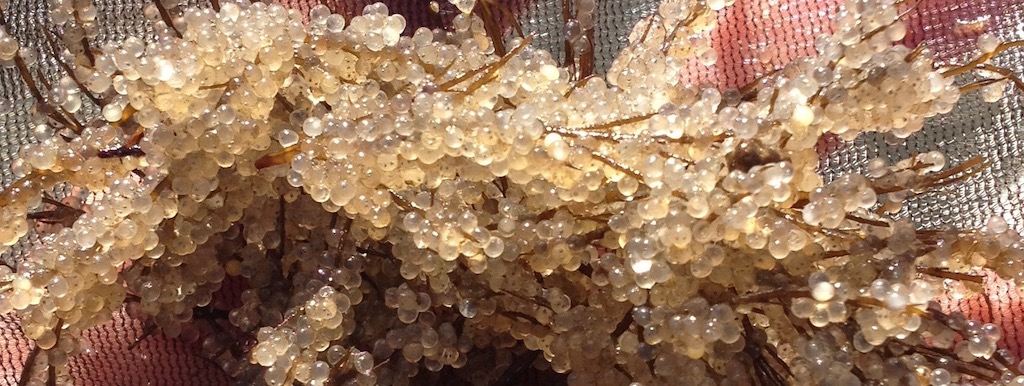
Pacific herring eggs from Puget Sound. Tessa Francis/Puget Sound Institute
Northern groups along the coast also transplanted herring eggs either from less viable to more viable areas or to areas where people wanted to revitalize or repopulate herring. More recent attempts have been made in the Salish Sea to follow this practice, but they have not been successful. In 1982 and 1984, biologists collected 17,000 and 9,000 kilograms of eggs that had washed ashore and transplanted them to suitable habitat. The eggs hatched but no adults ever returned to their natal site. Despite this failure, biologists wrote in a 2018 report that similar experiments could be attempted locally, as these attempts focused on windthrow eggs that were unlikely to survive. They caution, however, that they would not transplant any eggs until they fully understood the genetics of herring: recent studies have shown that the local populations have greater genetic diversity than initially suspected.
The long-term connection to herring manifest itself in one additional way within Puget Sound: Place names. In Hood Canal, William Elmendorf, an ethnologist who conducted field work in the 1930s and 1940s, wrote of three Twana (a Coast Salish language spoken by the Twana people of Hood Canal) place names that referred to the fish. On the east side of Quilcene Bay was a beach known as “landing for herring,” a reference to the location’s importance as a spawning ground. Further south were two locations known simply as herring. In Elliott Bay, there is also spot long known and still known as Herring’s House.
Recent genetic work has confirmed that the Native people of Puget Sound had a deep understanding of herring. The confirmation developed out of one of the curious aspects of herring in Puget Sound. The fish have a wide spawning window from January to June; in other localities the time range is much shorter. Working with modern herring DNA, Dr. Eleni Petrou of the University of Washington, has found that the spawn timing variation in the Sound reflects a genetic diversity. She hypothesized that the variation in spawning times has helped provide the resilience necessary to maintain herring, as well provide herring to Native groups over much of the year.
As part of her research, she worked with Suquamish and Puyallup tribal biologists to sequence herring bones from two archaeological sites. She found within each site the same genetic variation seen in modern herring, indicating a similar historical diversity in spawning times and use of multiple herring stocks by historical herring harvesters. “That they obtained herring from geographically and temporally diverse stocks shows that herring [diversity] was important for food security,” says Petrou.
A new market
When European settlers arrived in Puget Sound, they brought a much different perspective on herring. Instead of harvesting them for personal consumption, the newcomers saw the fish as a source of income. The initial market was San Francisco, which was by far the biggest on the west coast in the latter half of the nineteenth century. The earliest article in a Bay Area newspaper to mention Puget Sound herring appeared in the June 14, 1863, Daily Alta California. Wanting to draw attention to the potential for fisheries in Washington Territory and Puget Sound, the author noted how herring swarmed in the Sound, creating an “unsurpassed” fishery. Within a few years, papers throughout the Bay Area were listing the prices for smoked herring.
Not only did Puget Sound fishers sell smoked herring, they also shipped herring oil, which was used for greasing skin in tanneries and in logging camps as a skid grease. Oil was made by steaming the fish in wood boxes, then pressing the herring for oil. One barrel (a barrel held 200 pounds) of herring produced 1.5 gallons of oil. According to John P. Hammond, a local fisherman and entrepreneur who lived at Port Madison, at the north end of Bainbridge Island, his nightly haul of 200 to 300 barrels of fish could produce about 300 gallons of oil daily, which sold for 35 to 45 cents per gallon. Seeking to expand the market for herring, Hammond also planned to sell fish scraps to markets on the East coast for $20/ton but appears to have made little progress in this endeavor. Instead, he wrote in 1886 that herring stocks had begun to suffer in the Sound. Hammond blamed outsiders (apparently, he didn’t see himself as one), a lack of laws protecting the harvest, and mill owners, who dumped sawdust into the bays.
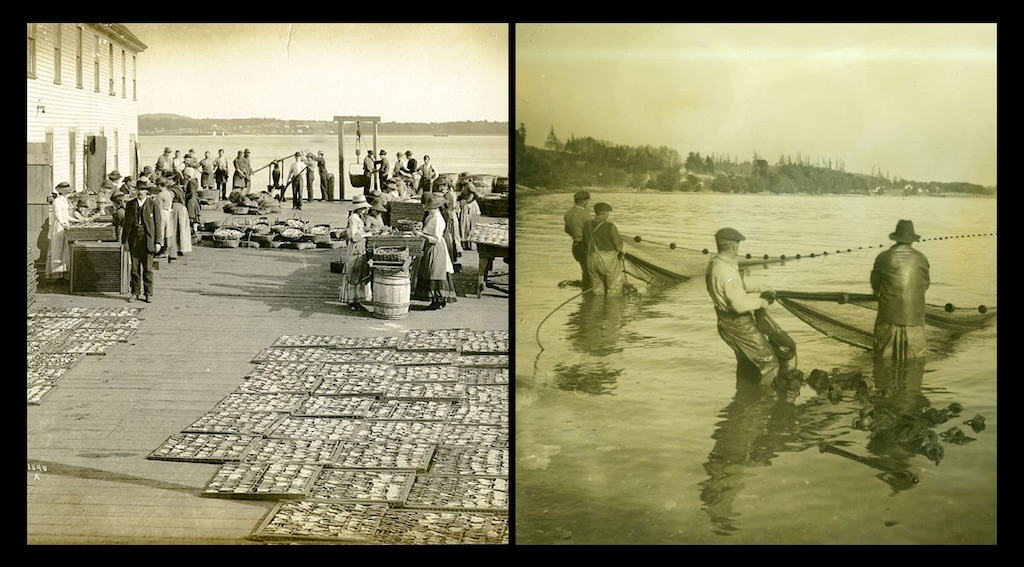
Commercial herring drying and processing business in the Puget Sound region, WA, ca. 1900 (left). Herring fishermen in the water off of Vashon Island ca. 1920 (right). Photos: Washington State Historical Society.
Despite Hammond’s concerns, commercial herring fisheries continued to operate throughout Puget Sound. Harvesters used brush weirs, purse seines, and drag seines and focused on spawning herring. Drag, or beach, seines were long, narrow nets that worked best in shallow water. Purse (meaning to close or gather together) seines were employed in the deep.
Curiously, the herring made it to very few dinner plates, either in Puget Sound or San Francisco. Most of the fish became bait, either fresh or frozen into cakes, primarily to catch halibut, cod, and soupfin shark.
Dwindling populations
But the plenty did not last. As herring populations began to dwindle, newspaper articles placed the blame on Italian fishermen, sawdust dumping, and poor harvesting practices, such as wrong mesh size, dynamiting, and fishing the spawning grounds. Another stated culprit was a whaling station on Vancouver Island — “kill the whales and the herring are not driven into Puget Sound,” wrote an unnamed reporter in the October 28, 1906, Morning Olympian. More likely, the reason was an unregulated fishery, which meant that commercial harvesters exploited the fish with little regard to the animals’ biology.
In 1915, the state of Washington finally passed laws to protect herring. The most effective of those created herring reserves at the most important spawning grounds: Port Hadlock (near Port Townsend), Holmes Harbor, Deception Pass, Jackson Cove (Hood Canal, next to Right Smart Cove), Hale Passage (Lummi Island), and Birch Bay Point. Catching fish during spawning season would be illegal within the reserves. As a result, the herring harvest dropped from two million pounds in 1915 to less than 165,000 pounds in 1921.
The smaller harvests allowed the fish to multiply quickly, which led ironically to higher harvest rates. Populations therefore crashed yet again in the late 1930s. By the late 1950s, they had recovered, which led to two decades of high harvests. In the south and central Sound, commercial operators targeted juvenile herring, which they caught as bait for recreational fishing. This fishery peaked in 1975 with a 1,223-ton harvest and continues to this day, though at a much-reduced rate. To the north in Bellingham Bay and the San Juan Islands, adult herring were caught and reduced to fish meal and oil. This fishery peaked in 1969 with a 3,669-ton harvest and closed in 1983. And, finally, beginning in 1972 a sac-roe fishery developed around Cherry Point, north of Bellingham Bay. Using seines and gillnets (fish swim into a vertical net that allows their heads but not their bodies through the netting; as the fish struggle, they get trapped by their gills), fishers caught adult herring, extracted the females’ egg sacs, and sold the roe, primarily to Japanese markets. This fishery peaked in 1974 with a 4,450-ton harvest and closed in 1981. At present, south Sound bait fishing, which annually averages only six harvesters and a 270-ton catch, is the only herring fishery in Puget Sound, taking less than six percent of total estimated spawning biomass. There are no tribal fisheries for herring in Puget Sound.
New threats
Unlike previous cycles, herring numbers have not responded since the curtailment of the fisheries in the early 1980s. In 2004, a coalition of six organizations and one individual filed a petition with the National Marine Fisheries Service to have herring in Puget Sound listed as threatened or endangered under the Endangered Species Act. Specifically, the petitioners sought protection for herring that spawned at Cherry Point. Historically the largest stock in the Sound, the population had plummeted by ninety percent between 1973, when biologists first acquired accurate numbers, and 2004. Threats to the herring named in the petition included industrial development and pollution, such as docks, toxic pollution, vessel traffic, noise pollution, and ballast water. In June 2005, federal biologists rejected the petition, finding that while the Cherry Point stock was discrete from other Puget Sound herring in spawn timing and location, it did not meet the criteria for being significant for the survival of the Pacific herring taxon, which is widely spread across the North Pacific Rim.
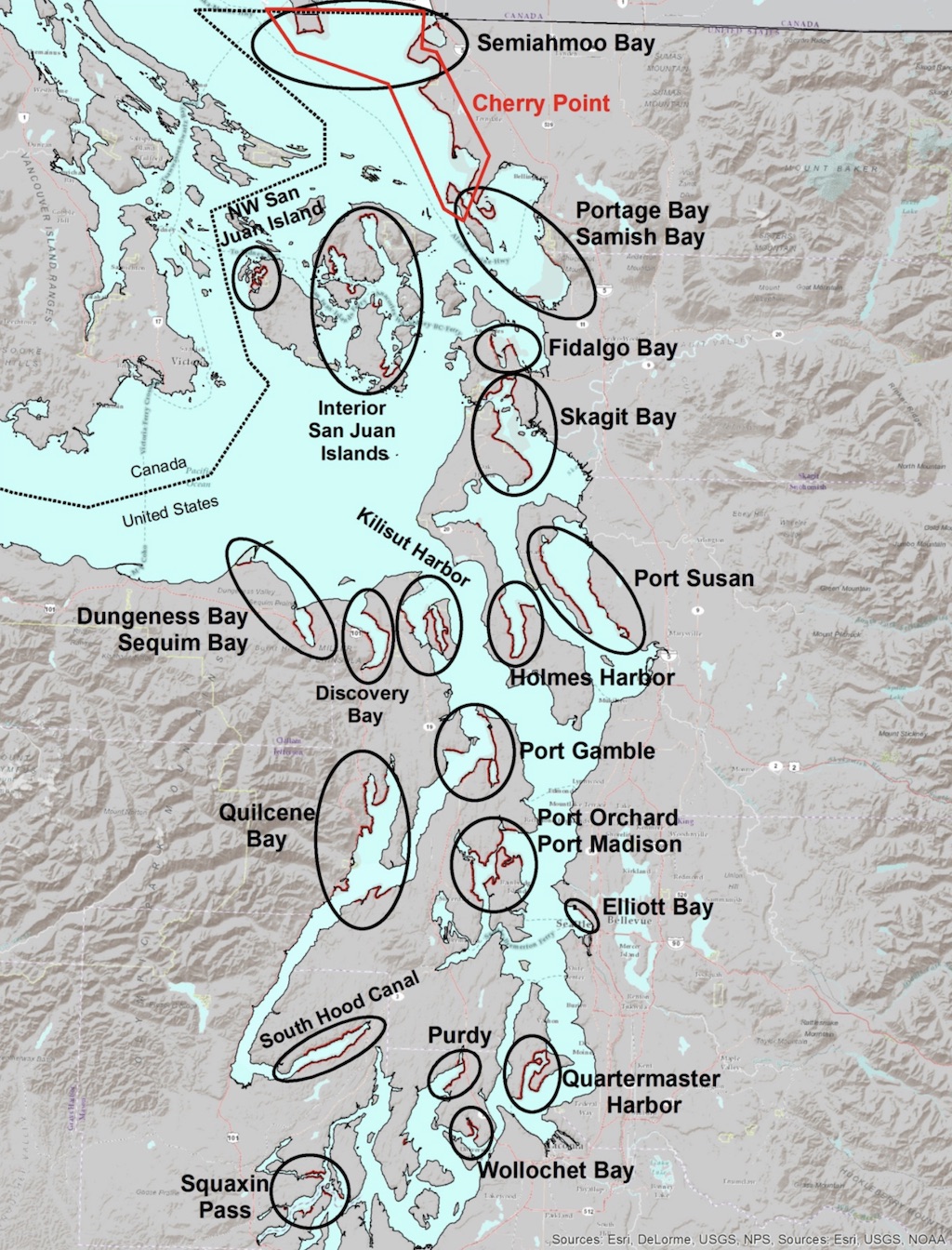
Washington Department of Fish and Wildlife map showing documented Puget Sound herring spawning grounds. Map: WDFW 2014.
Biologists use the term stock, when discussing herring, to refer to fish that reproduce at localized spawning grounds, a useful management unit because of how specific populations of herring return annually to spawn at the same time of year at the same location. In practical terms, this allows fisheries managers to direct their efforts at individual stocks of genetically-related fish based on recent abundance compared with a 25-year mean. Stocks are also a useful concept for managing herring because of the strong connection between Native harvesters and herring spawning activities near their settlements; cultural and social activities and traditions are associated with local herring stocks. Within greater Puget Sound, which stretches from the 49th parallel to Dungeness Spit to the South Sound, there are 21 recognized herring stocks.
As of 2018, Washington State Department of Fish and Wildlife biologists estimated that the Puget Sound herring cumulative spawning biomass was about 9,500 tons. This compares with a peak estimate of 28,000 tons in 1970 (this number is very much an estimate and is based on extrapolating more recent numbers back to earlier years). Based on this information, the biologists have categorized herring stocks to be moderately healthy, meaning the fish have not reached a point that permanent damage is likely to the fish stocks.
Not all the herring stocks in the Sound have fared the same. Four are expanding, in particular Quilcene Bay, which is the largest in the waterway. One is moderately healthy, seven are depressed, six are critical, and three have insufficient data. Of the latter, one is in Elliott Bay, where no herring were known to spawn until 2012.
Despite the numbers, biologists don’t think that herring in Puget Sound are past the point of no return. Current limits on Puget Sound herring recovery include predation by increasing populations of harbor seals and other marine mammals, shoreline development, toxic pollution, industrial activities, egg predation by ducks and other egg predators that may keep depressed herring stocks stuck at low levels, and disease. However, biologists point to herring’s amazing reproductive potential, which gives them the ability to rapidly expand their populations. Experts also observe that as we have begun to better understand the biology of herring, how they interact with other species, and how humans impact them, we are getting a better grasp on what people in Puget Sound need to do to allow herring to bounce back. The big question, they say, is whether we have the commitment to allow this to happen.

